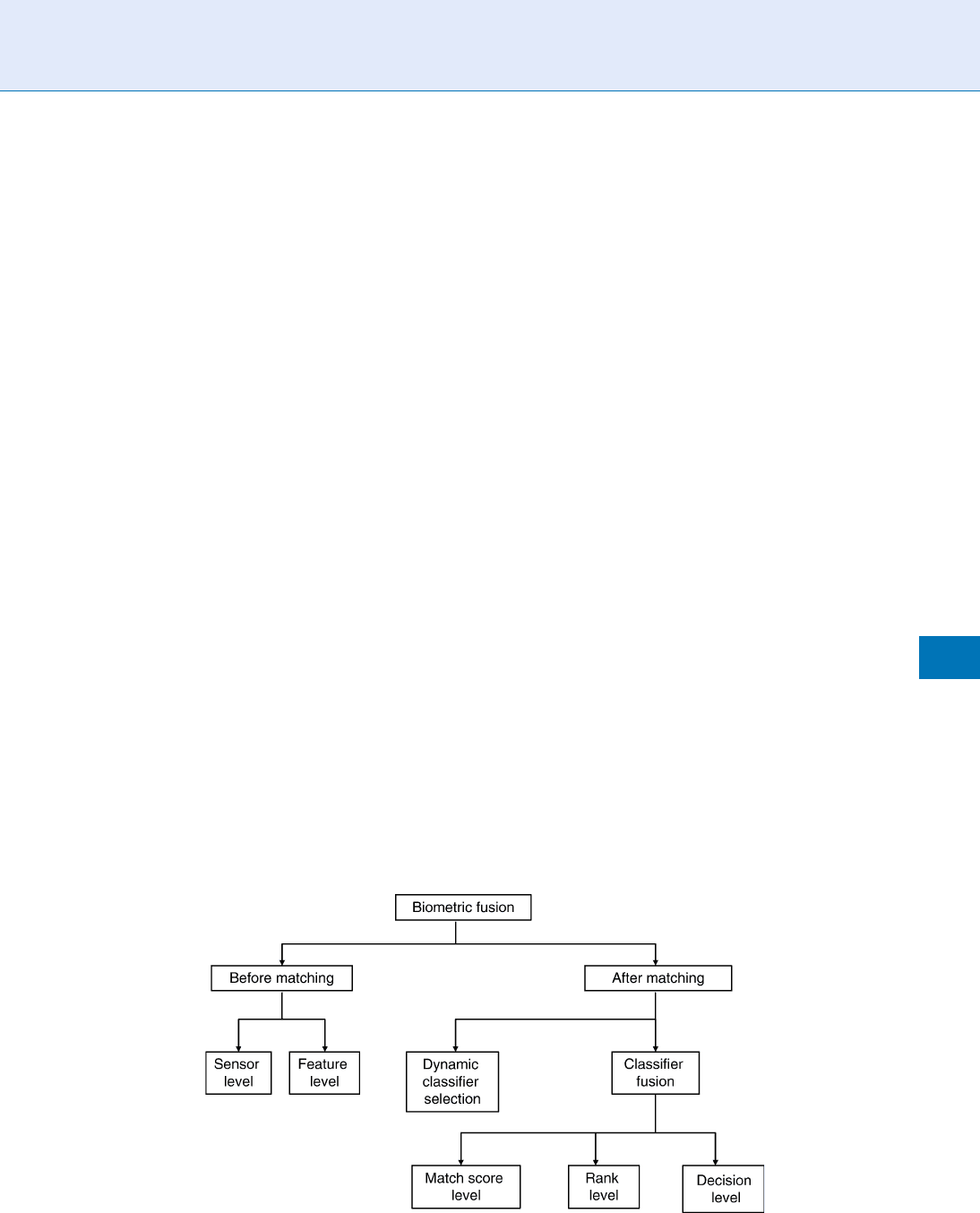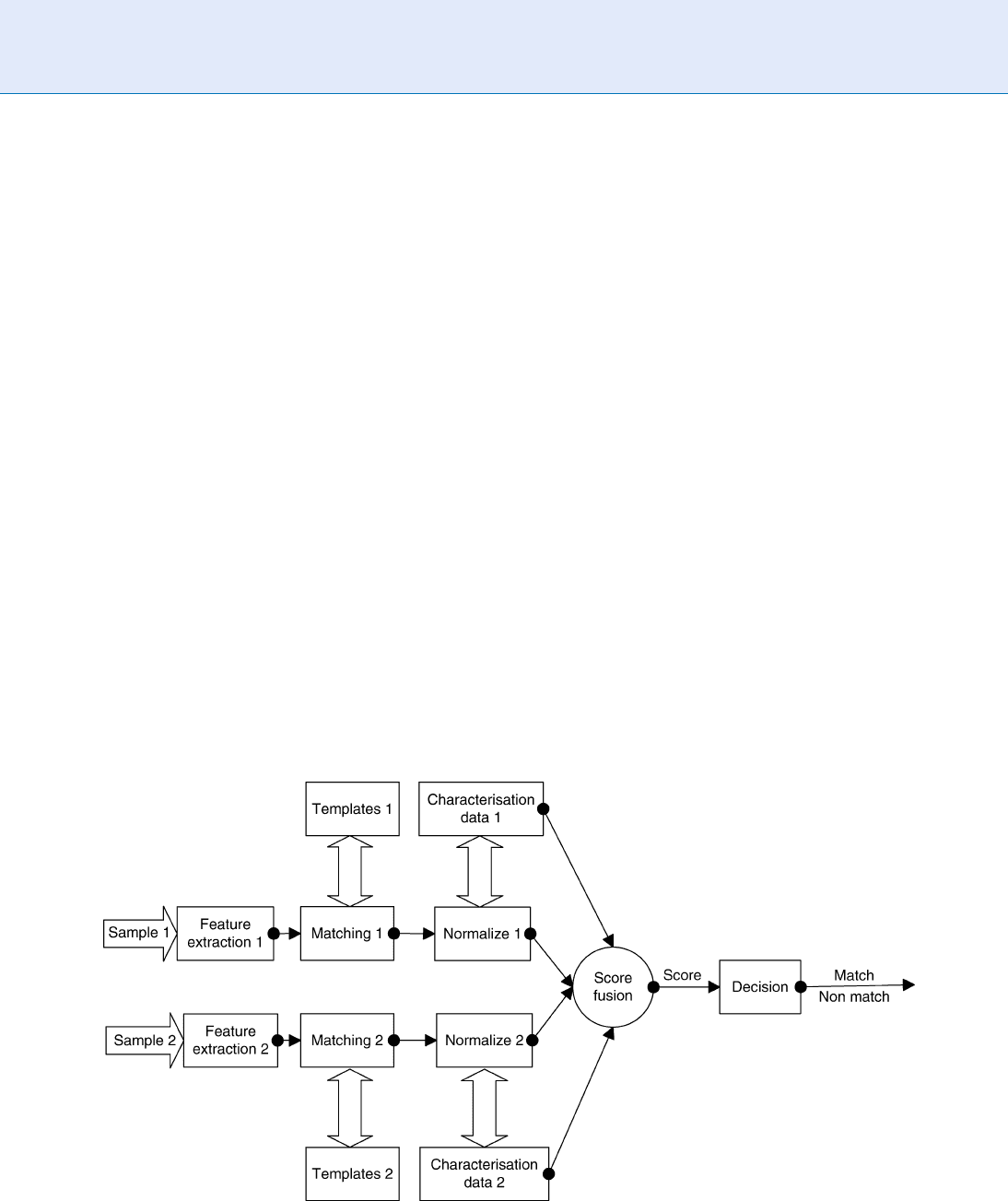Li S.Z., Jain A.K. (eds.) Encyclopedia of Biometrics
Подождите немного. Документ загружается.


thereby demanding the design of an effective (and
possibly more expensive) acquisition device.
4. Multi-sample systems. A single sensor may be used
to acquire multiple samples of the same biometric
trait to account for the variations that can occur in
the trait, or to obtain a more complete representa-
tion of the underlying trait. A face system , for
example, may capture (and store) the frontal pro-
file of a person’s face along with the left and right
profiles in order to account for variations in the
facial pose. Similarly, a fingerprint system equipped
with a small size sensor may acquire multiple dab
prints of an individual’s finger to obtain images of
various regions of the fingerprint. A mosaicing
scheme may then be used to stitch the multiple
impressions and create a composite image. One of
the key issues in a multi-sample system is deter-
mining the number of samples that have to be
acquired from an individual. It is important that
the procured samples represent the variability as
well as the typicality of the individual’s biome-
tric data. To this end, the desired relationship
between the samples has to be established before-
hand to optimize the benefits of the integration
strategy. For example, a face recognition system
utilizing both the frontal- and side-profile images
of an individual may stipulate that the side-profile
image should be a three-quarter view of the face.
Alternately, given a set of biometric samples, the
system should be able to automatically select
the ‘‘optimal’’ subset that would best represent the
individual’s variability.
5. Multimodal systems. Multimodal systems establish
identity based on the evidence of multiple biomet-
ric traits. For example, some of the earliest multi-
modal biometric systems utilized face and voice
features to establish the identity of an individual .
Physically uncorrelated traits (e.g., fingerprint and
Multibiometrics. Figure 1 Sources of information for biometric fusion.
970
M
Multibiometrics

iris) are expected to result in better improvement
in performance than the correlated traits (e.g.,
voice and lip movement). The cost of deploying
these systems is substan tially more due to the re-
quirement of new sensors and, consequently, the
development of appropriate user interfaces. The
identification accuracy can be significantly im-
proved by utilizing an increasing number of traits
although the
▶ curse-of-dimensionality phenome-
non would impose a bound on this number. The
number of traits used in a specific application will
also be restricted by practical considerations such
as the cost of deployment, enrollment time,
throughput time, expected error rate, user habitu-
ation issues, etc.
6. Hybrid systems. Chang et al. [7] use the term hybrid
to describe systems that integrate a subset of
the five scenarios discussed above. For example,
Brunelli et al. [8] discuss an arrangement in which
two speaker recognition algorithms are combined
with three face recognition algorithms at the match
score and rank levels via a HyperBF network. Thus,
the system is multi-algorithmic as well as multi-
modal in its desig n.
Levels of Fusion
Based on the type of information available in a certain
module, different levels of fusion may be defined.
Sanderson and Paliwal [9] categorize the various levels
of fusion into two broad categories: pre-classification
or fusion before matching, and post-classification or
fusion after matching (see Fig. 2). Such a categoriza-
tion is necessary since the amount of information
available for fusion reduces drastically once the match-
er has been invoked. Pre-classification fusion schemes
typically require the development of new matching
techniques (since the matchers used by the indiv idual
sources may no longer be relevant) thereby introdu-
cing additional challenges. Pre-classification schemes
include fusion at the sensor (or raw data) and the
feature levels while post-classification schemes include
fusion at the match score, rank and, dec ision levels.
1. Sensor-level fusion. The raw biometric data (e.g.,
a face image) acquired from an individual repre-
sents the richest source of information although it
is expected to be contaminated by noise (e.g ., non-
uniform illumina tion, background clutter, etc.).
Sensor-level fusion refers to the consolidation of
(1) raw data obtained using multiple sensors, or
(2) multiple snapshots of a biometric using a
single sensor.
2. Feature-level fusion. In feature-level fusion, the fea-
ture sets originating from multiple biometric algo-
rithms are consolidated into a single feature set by
the application of appropriate feature normalization,
transformation, and reduction schemes. The primary
benefit of feature-lev el fusion is the detection of
corr elated featur e values generated by different bio-
metric algorithms and, in the process, identifying a
salient set of features that can improve recognition
accuracy. Eliciting this feature set typically requires
Multibiometrics. Figure 2 Fusion can be accomplished at various levels in a biometric system.
Multibiometrics
M
971
M

the use of dimensionality reduction methods and,
therefore, feature-level fusion assumes the availability
of a large number of training data. Also, the feature
sets being fused are typically expected to reside in
commensurate vector space in order to permit the
application of a suitable matching technique upon
consolidating the feature sets.
3. Score-level fusion. In score-level fusion the match
scores output by multiple biometric matchers
are combined to generate a new match score (a
scalar) that can be subsequently used by the verifica-
tion or identification modules for rendering an iden-
tity decision. Fusion at this level is the most
commonly discussed approach in the biometric lit-
erature primarily due to the ease of accessing and
processing match scores (compared to the raw bio-
metric data or the feature set extracted from the
data). Fusion methods at this level can be broadly
classified into three categories: density-based
schemes, transformation-based schemes, and classi-
fier-based schemes.
4. Rank-level fusion. When a biometric system oper-
ates in the identification mode, the output of the
system can be viewed as a ranking of the enrolled
identities. In this case, the output indicates the set of
possible matching identities sorted in decreasing
order of confidence. The goal of rank level fusion
schemes is to consolidate the ranks output by
the individual biometric subsystems to derive a
consensus rank for each identity. Ranks provide
more insight into the decision-making process of
the matcher compared to just the identity of the
best match, but they reveal less information than
match scores. However, unlike match scores, the
rankings output by multiple biometric systems are
comparable. As a result, no normalization is needed
and this makes rank level fusion schemes simpler
to implement compared to the score level fusion
techniques.
5. Decision-level fusion. Many commercial off-the-
shelf (COTS) biometric matchers provide access
only to the final recognition decision. When such
COTS matchers are used to build a multibiometric
system, only decision level fusion is feasible. Meth-
ods proposed in the literature for decision level
fusion include ‘‘AND’’ and ‘‘OR’’ rules, majority
voting, w eighted majority voting, Bayesian decision
fusion, the Dempster–Shafe r theor y of evidence,
and behavior knowledge space.
Summary
Multibiometric systems are expected to enhance the
recognition accuracy of a personal authentication sys-
tem by reconciling the evidence presented by multiple
sources of information. Typically, early integration
strategies (e.g., feature-level) are expected to result in
better performance than late integration (e.g., score-
level) strategies. However, it is difficult to predict the
performance gain due to each of these strategies prior to
invoking the fusion methodology. While the availability
of multiple sources of biometric information (pertain-
ing either to a single trait or to multiple traits) may
present a compelling case for fusion, the
▶ correlation
between the sources has to be examined before deter-
mining their suitability for fusion [10]. Combining
uncorrelated or negatively correlated sources is expected
to result in a better improvement in matching perfor-
mance than combining positively correlated sources
[11]. However, defining an appropriate diversity mea-
sure to predict fusion performance has been elusive
thus far. Other topics of research in multibiometrics
include (1) protecting multibiometric templates;
(2) indexing multimodal databases; (3) consolidating
biometric sources in highly unconstrained non-ideal
environments; (4) designing dynamic fusion algo-
rithms to address the problem of incomplete input
data; and (5) predicting the matc hing performance
of a multibiometric system.
Related Entries
▶ Fusion, Decision-Level
▶ Fusion, Feature-Level
▶ Fusion, Rank-Level
▶ Fusion, Score-Level
▶ Fusion, Sensor-Level
▶ Multiple Classifier Systems
▶ Multiple Experts
References
1. Bigun, E.S., Bigun, J., Duc, B., Fischer, S.: Expert Conciliation
for Multimodal Person Authentication Systems using Bayesian
Statistics. In: Proceedings of First International Conference
on Audio- and Video-Based Biometric Person Authentication
(AVBPA), pp. 291–300. Crans-Montana, Switzerland (1997)
2. Hong, L., Jain, A.K., Pankanti, S.: Can Multibiometrics Improve
Performance? In: Proceedings of IEEE Workshop on Automatic
972
M
Multibiometrics

Identification Advanced Technologies (AutoID), pp. 59–64. New
Jersey, USA (1999)
3. Ross, A., Nandakumar, K., Jain, A.K.: Handbook of Multibio-
metrics. 1st ed. Springer, New York, USA (2006)
4. Jain, A.K., Ross, A.: Multibiometric Systems. Communications of
the A CM, Special Issue on Multimodal Interfaces 47(1), 34–40
(2004)
5. Kuncheva, L.I.: Combining Pattern Classifiers - Methods and
Algorithms. Wiley (2004)
6. Ho, T.K.: Multiple Classifier Combination: Lessons and Next
Steps. In: H. Bunke, A. Kandel (eds.) Hybrid Methods in Pattern
Recognition, Machine Perception and Artificial Intelligence,
vol. 47, pp. 171–198. World Scientific (2002)
7. Chang, K.I., Bowyer, K.W., Flynn, P.J.: An Evaluation of Multi-
modal 2D+3D Face Biometrics. IEEE Transactions on Pattern
Analysis and Machine Intelligence 27(4), 619–624 (2005)
8. Brunelli, R., Falavigna, D.: Person Identification Using Multiple
Cues. IEEE Transactions on Pattern Analysis and Machine Intel-
ligence 17(10), 955–966 (1995)
9. Sanderson, C., Paliwal, K.K.: Information Fusion and Person
Verification Using Speech and Face Information. Research
Paper IDIAP-RR 02-33, IDIAP (2002)
10. Poh, N., Bengio, S.: How Do Correlation and Variance of Base-
Experts Affect Fusion in Biometric Authentication Tasks?. IEEE
Transactions on Signal Processing 53(11), 4384–4396 (2005)
11. Kuncheva, L.I., Whitaker, C.J., Shipp, C.A., Duin, R.P.W.: Is
Independence Good for Combining Classifiers? In: Proceedings
of International Conference on Pattern Recognition (ICPR),
vol. 2, pp. 168–171. Barcelona, Spain (2000)
Multibiometrics and Data Fusion,
Standardization
JUNG SOH
1
,FARZIN DERAVI
2
,ALESSANDRO TRIGLIA
3
,
A
LEX BAZIN
4
1
University of Calgary, Calgary, AB, Canada
2
University of Kent, Canterbury, Kent, UK
3
OSS Nokalva, Inc., Somerset, NJ, USA
4
Fujitsu Services, London, UK
Synonyms
Biometric fusion standardization; Multibiometric
fusion standardization
Definition
Multibiometrics is the automated recognition of indi-
viduals based on their biological or behavioral charac-
teristics and involves the use of biometric fusion. Some
applications of biometrics require a level of technical
performance that is difficult to obtain with a single
biometric measure. Preventing illegitimate multiple
applications by the same individual for national iden-
tity cards and checking security for air travel are exam-
ples of such applications. In addition, provision is
needed for people who are unable to give a reliable
biometric sample for some biometric modalities. Use
of multiple biometric measurements from substan-
tially independent biometric sens ors, algo rithms, or
modalities typically gives improved technical perfor-
mance, increases system flexibility and reduces security
risks. This includes an improved level of performance
where not all biometric measurements are available
such that decisions can be made from any number of
biometric measurements within an overall policy on
accept/reject thresholds. At the current level of under-
standing, combining results from different biometric
sources at the matching score level typically requires
knowledge of both genuine and impostor distribu-
tions of such scores. Such distributions are highly
application-dependent and generally unknown in
any real system. Research on the methods not requir-
ing previous knowledge of the score distributions is
continuing and research on fusion at both the image
and feature levels is still progressing. Preliminary work
on ISO/IEC international standardization of multibio-
metrics has culminated in a Technical Report, while in
the United States substantial progress has been made
on standards to support multibiometrics.
Overview of Multibiometric Systems
In general, the use of the terms ▶ multimodal or
▶ multibiom etric indicates the presence and use of
more than one
▶ biometric modality, sensor, instance,
and/or algorithm in some form of combined use for
making a specifi c biometric identification or verifica-
tion decision. The methods of combining multiple
samples, matching scores, or matching decisions can
be very simple or mathematically complex.
Multimodal biometrics were first proposed, imple-
mented and tested in the 1970s. Co mbining measures
was seen as a necessary future requirement for biomet-
ric systems. It was widely thought that combining
multiple measures could increase either security by
decreasing the false acceptance rate or user conve-
nience by decreasing the false rejection rate. These
Multibiometrics and Data Fusion, Standardization
M
973
M

early systems, however, did not seem to advance into
practical applications.
The use of fusion and related methods has been a
key tool in the successful implementation of large-scale
automated fingerprint identification systems (AFISs),
starting in the 1980s. Until recently, multiple modal-
ities have not been used in AFIS; however, many meth-
ods of fusion have been successfully implemented
using fingerprints alone. Some of the ways that fusion
has been implemented in AFISs include:
1. Image (i.e., sample) fusion in creating a single
‘‘rolled’’ image from a series of plain impressions
on a livescan device.
2. Template fusion in the use of multiple feature ex-
traction algorithms on each fingerprint image.
3. Multiinstance fusion in the use of fingerprints from
all ten fingers.
4. Multipresentation fusion in the use of rolled and
slap (plain) fingerprints.
5. Algorithm fusion for the purpose of efficiency
(cost, computational complexity, and throughput
rate); generally matchers are used as a series of
filters in order of increasing computational com-
plexity. These are generally implemented as a mix
of decision- and score-level fusion.
6. Algorithm fusion for the purpose of accuracy (de-
creasing false accept rate and/or false reject rate,
lessening sensitivity to poor-quality data); matchers
are used in parallel, with fusion of resulting scores.
The use of fusion has made AFISs possible, because
of fusion’s increase in both accuracy and efficiency.
To further understand the distinction among the
multib iome tric categori es, Table 1 illustrate s the
basic distinctions among categories of multibiometric
implementation. The key aspect of the category that
makes it multi-‘‘something’’ is shown in boldface.
Multimodal biometric systems take input from single
or multiple sensors that capture two or more biometric
characteristics of different modalities. For example, a sin-
gle system c ombining face and iris information for bio-
metric recognition would be considered a ‘ ‘ multimodal’’
system regardless of whether face and iris images were
captured by different imaging devices or the same device.
It is not required that the various measures be mathemat-
ically combined in any way. For example, a system with
fingerprint and voice recognition would be considered
‘‘multimodal’’ even if the ‘‘OR’’ rule was being applied,
allowing users to be verified using either of the modalities.
Multialgorithmic biometric systems receive a sing le
sample from a single sensor and process that sample
with two or more algorithms. This technique could be
applied to any modality. Maximum benefit (theoreti-
cally) would be derived from algorithms that are based
on distinctly different and independent principles
(such algorithms may be called ‘‘orthogonal’’).
Multiinstance biometric systems use one (or possi-
bly multiple) sensor(s) to capture samples of two or
more different instances of the same biometric character-
istic. For example, systems capturing images from multi-
ple fingers are considered to be multiinstance rather than
multimodal. However, systems capturing, for example,
sequential frames of facial or iris images are considered to
be multipresentation rather than multiinstance.
Multisensorial biometric systems sample the same
instance of a
▶ biometric characteristic with two or
more distinctly different sensors. Processing of the
multiple samples can be done with one algorithm, or
Multibiometrics and Data Fusion, Standardization. Table 1 Multibiometric categories illustrated by the simplest case
of using 2 of something
Category Modality Algorithm Biometric characteristic (e.g., body part) Sensor
Multimodal 2 (always) 2 (always) 2 (always) 2 (usually)
a
Multialgorithmic 1 (always) 2 (always) 1 (always) 1 (always)
Multiinstance 1 (always) 1 (always) 2 instances of 1 characteristic (always) 1 (usually)
b
Multisensorial 1 (always) 1 (usually)
c
1 (always, and same instance) 2 (always)
Multipresentation 1 1 1 1
a
Exception: a multimodal system with a single sensor used to capture two different modalities (e.g., a high resolution image used to
extract face and iris or face and skin texture)
b
Exception may be the use of two individual sensors each capturing one instance (e.g., possibly a two-finger fingerprint sensor)
c
It is possible that two samples from separate sensors could be processed by separate ‘‘feature extraction’’ algorithms, and then through
a common comparison algorithm, making this ‘‘1.5 algorithms,’’ or two completely different algorithms
974
M
Multibiometrics and Data Fusion, Standardization

some combination of multiple algorithms. For exam-
ple, a face recognition application could use both a
visible light camera and an infrared camera coupled
with a specific frequency (or several frequencies) of
infrared illumination.
For a specific application in an operational envi-
ronment, there are numerous system design considera-
tions, and trade-offs that must be made, among factors
such as improved performa nce (e.g., identification or
verification accuracy, sy stem speed and throughput,
robustness, and resource requirements), acceptabi lity,
ease of circumvention, ease of use, operational cost,
environmental flexibility, and population flexibility
[1]. Especially for a large-scale human identification
system, there are additional system design considera-
tions suc h as operation and maintenance, reliability,
system acquisition cost, life cycle cost, and planned
system response to identified susceptible means of
attack, all of which will affect the overall deployability
of the system [1].
Levels of Combination
As a basis for the definition of levels of combination in
multibiometric systems, Fig . 1 shows a sing le-biome tric
process. A biometric sample captured by a biometric
sensor (e.g., a fingerprint image) is fed into the feature
extraction module. Using sign al processing methods,
the feature extraction modu le converts a sample into
features (e.g., fingerprint minutiae), which form a rep-
resentation apt for matching. Usually, multiple features
are collected into a feature vector. The matching mod-
ule takes the feature vector as input and compares it to
a stored template (a type of biometric reference, as
defined in [2]). The result is a match score, which is
used by the decision module to decide (e.g., by applying
a threshold) whether the presented sample matches
with the stored template. The outcome of this decision
is a binary match or non-match. Generalizing the
above process to a multibiometric one, there are sever-
al levels at which fusion can take place: (1) decision
level; (2) match score level; (3) feature level; and (4)
sample level.
Decision-level fusion takes place only after the
results of matching from all biometric components
are available. The decision module outputs match or
non-match as a binary decision value. If a biometric
system consists of a small number of biometric com-
ponents, assigning logical values to match outcomes
allows fusion rules to be formulate d as logical func-
tions. For two decision-level outputs, two most com-
monly used logical functions are logical AND and
OR. For many decision-level outputs, various voting
schemes can be used as fusion rules, the most common
of which is majority voting. The logic al AND and OR
functions can be considered as voting schemes.
In score-level fusion, each system provides match-
ing scores indicating the proximity of the feature vec-
tor with the template vector. These scores can then be
combined to improve the matching performance. The
match score output by a matcher contains the richest
information about the input biometric sample in the
absence of feature-level or sensor-level information.
Furthermore, it is relatively easy to access and combine
the scores generated by several different matchers. Con-
sequently, integration of information at the match score
level is the most common approach in multimodal
biometric systems. From a theoretical point of view,
biometric processes can be combined reliably to give a
guaranteed improvement in matching performance.
Any number of suitably characterized biometric pro-
cesses can have their matching scores combined in
such a way that the multibiometric combination is
guaranteed (on average) to be no worse than the best
of the individual biometric devices. The key is to
Multibiometrics and Data Fusion, Standardization. Figure 1 Generic single-biometric process. (Reproduced from
Figure 2, Section 5.1 of ISO/IEC TR 24722:2007 Information technology – Biometrics – Multimodal and other
multibiometric fusion).
Multibiometrics and Data Fusion, Standardization
M
975
M

identify correctly the method which will combine these
matching scores reliably and maximize the improve-
ment in matching performance. The mechanism (for
this sort of good combination of scores within a multi-
biometric system) must follow at least two guidelines:
(1) each biometric process must produce a score and
make it available to the multibiometric combiner;
and (2) in advance of operational use, each biometric
process must make available to the multibiometric
combiner, its technical performance (such as score dis-
tributions) in the appropriate form (and w ith sufficient
accuracy of characterization). Both verification (1:1) and
identification (1:N) systems can support fusion at the
match score level.
In the context of verification, there are two distinct
approaches to formulate a score-level fusion problem:
(1) classification; and (2) combination [3]. In the clas-
sification approach, a feature vector is constructed
using the matching scores output by the individual
matchers; thi s feature vector is then classified into
one of two classes: ‘‘Accept’’ (genuine user) or ‘‘Reject’’
(impostor). Generally, the classifier used for this pur-
pose (e.g., decision tree, neural network, support vec-
tor machine, k-nearest neighbor, random forest, etc.) is
capable of learning the decision boundary, given some
training data, irrespective of how the feature vector is
generated [4]. Hence, the output scores of the different
modalities can be non-homogeneous (distance or similar-
ity metric, different numerical ranges, etc.) and no proces-
sing is required prior to presenting them to the classifier .
In the combination approach (see Fig. 2), the individual
matching scores are combined to generate a single scalar
score, which is then used to make the final decision [5]. To
ensure a meaningful combination of the scores from
the different modalities, if necessary, the scores may be
first transformed to a common domain prior to com-
bining them. This is known as score normalization.
Score normalization methods attempt to map the
scores of each biometric process to a common domain.
Some reasons why scores need to be normalized prior to
fusion include [3]: (1) the matching scores at the output
of the individual matchers may not be homogeneous.
For example, one matcher may output a distance (dis-
similarity) measure while another may output a proxim-
ity (similarity) measure; (2) the outputs of the individual
matchers need not be on the same numerical scale
(range); and (3) the matching scores at the output of
the matchers may follow different statistical distribu-
tions. Some approaches are based on the Neyman-
Pearson lemma [6], with simplifying assumptions. For
example, mapping scores to likelihood ratios allows
them to be combined by multiplying under an
Multibiometrics and Data Fusion, Standardization. Figure 2 A framework for score-level fusion using
combination approach. (Reproduced from Figure 5, Section 5.3.2 of ISO/IEC TR 24722:2007 Information technology –
Biometrics – Multimodal and other multibiometric fusion).
976
M
Multibiometrics and Data Fusion, Standardization

independence assumption. Other approaches may be
based on modifying other statistical measures of the
match score distributions. The parameters used for
normalization can be determined using a fixed training
set or adaptively based on the current feature vector.
In feature-level fusion, biometric information is
fused after feature extraction but before matching.
The simplest form is to integrate the feature vectors
(or sets if there is no implicit correspondence) of com-
ponent biometrics and to apply feature classification
methods to the combined feature vector. Where features
from contributing multibiometrics are not indepen-
dent, good feature-level combination should, in
some circumstances, allow dependencies to be more
fully exploited than by solely using score-level combina-
tion. This should give better overall performance. How-
ever, fusion at this level is difficult to achieve in practice
because of the following reasons: (1) the feature
vectors of multiple modalities may be incompatible
(e.g., minutiae set of fingerprints and Eigen-coefficients
of face); (2) the relationship between the feature spaces
of different biometric systems may not be known;
(3) concatenating two feature vectors may result in a
feature vector with very large dimensionality leading to
the ‘‘curse of dimensionality’’; and (4) a significantly
more complex matcher might be required in order to
operate on the concatenated feature vector [7].
Notwithstanding these challenges, fusion at the
feature level has been attempted in several contexts.
Chang et al. [8] demonstrate feature-level fusion of
face and ear modalities showing significant improve-
ments in performance. Kumar et al. [9] integrate the
palm-print and hand geometry features of an individ-
ual in order to enhance matching performance. In
their experiments, fusion at the match score level was
observed to be superior to fusion at the feature level.
However, Ross and Govindarajan [2] combine the
hand and face modalities of a user (multibiometrics)
as well as the R, G, B channels of the face image
(multisensorial) of a user at the feature level and dem-
onstrate that a feature selection scheme may be neces-
sary to improve matching performance at thi s level.
State of International Standardization of
Multibiometrics
At the time of this writing (late 2008), no standards on
multibiometrics have been developed within ISO/IEC.
However, the ISO/IEC subcommittee on biometrics
(ISO/IEC JTC 1/SC 37) had instead produced a Technical
Report on multibiometrics [10] (hereafter referred
to as the ‘‘Technical Report’’), which contains descrip-
tions and analyses of current practices on multibio-
metric fusion and provides useful information for
future development of international standards in
this area.
According to the Technical Report, there are many
ways of combining multibiometric processing and
performing
▶ biometric fusion, not all of which can
be made part of a biometric fusion standard. It is likely
that future biometric fusion standardization activity
within ISO/IEC will be of five types:
1. Record formats: The definition and standardization
of data to be exchanged be tween processes and
stored on various media. The biometric data inter-
change formats specified in SC 37/WG 3 standards
are examples of this type of standard. Another
example is the Fusion Information Format national
standard developed in the US [11]
2. Interfaces: Definition of standard APIs for pro-
cesses, the record formats used by the processes,
and the initialization procedure of the processes in
a system. The BioAPI standard [12] developed in
SC 37/WG 2 is an example of this type of standard,
which mig ht have to be modified in order to sup-
port multibiometrics and fusion data. The US ver-
sion of the BioAPI standard [13] has been amended
[14] to support biometric fusion
3. Application profile: A standard containing a list of
references to provisions of one or more other stan-
dards, which are specified as optional in those
standards but are made mandatory by this standard
in order to facilitate interoperability in a particular
set of use cases. The SC 37/WG 4 project on ILO
(International Labor Organization) Seafarer ID
profile [15] is an example of this type of standard
4. Conformance testing: A description of the criteria
and test data that allows for the assurance that
systems have complied with the standards. These
types of standards are under development in SC 37
for the biometric record formats
5. Per formance testing: Online testing of biometric
systems is complicated by the implied existence of
multiple and sequential sensors. A testing protocol
that develops procedures for doing this should be
established
Multibiometrics and Data Fusion, Standardization
M
977
M

The use of multibiometric systems has been consid-
ered for two major and differing use cases. The first is
high-securi ty biometric use where the combination of
biometrics provides a stronger assurance of impostor
rejection for a relatively small, trained population.
The second is in the context of large-scale ID systems,
such as travel document systems, where the multibio-
metric combination may provide for the reduction of
rejection rates and easier system usage for a very large,
untrained population. In the context of the large-scale
ID systems, there can be many solution providers
providing components to the overall system. For ex-
ample, the creator of the electronic biometric docu-
ment may not be the same vendor that creates the
physical document, and neither may be the vendor
that performs the biometric test(s) (verification
or identification) during the document’s usage. This
situation can clearly benefit from a biometric fusio n
standard when the document contains multiple
biometrics.
In the context of biometric fusion, one can propose
the following multibiometric system interoperability
requirements:
1. Standard multibiometric systems may be required
to be designed and certified (or evaluated) based on
common performance requirements. These perfor-
mance requirements should be independent of the
biometric modalities in use. This includes perfor-
mance measures such as failure to enroll, failure to
acquire, false rejection rate, false acceptance rate,
system throughput, and the resistance to active
impostor attacks
2. Standard multibiometric systems may be required
to be designed so that a single biometric subsystem
can be separately upgraded. All biometric device
characteristics change over time as research and
development improves accuracy and lowers cost.
The development of each biometric system however,
proceeds on its own timeline. Therefore only if
separate upgrading is possible it will be convenient
to upgrade a multib iometric system in the field
3. A standard multibiometric system may be required
to be able to accept historical information for a
given user, such as scores and processing times.
With this information, the system can be optimized
in both security and throughput to take advantage
of the type of biometric modality that is favored by
the particular user
4. Standard multibiometric systems may be required
to be compatible with existing standard-based sys-
tems that use a single biometric characteristic. To
achieve support of the system requirements, exist-
ing biome tric technical interfaces, such as the
BioAPI standard, may need to be revised to provide
support for fusion while allowing the use of inde-
pendently developed BioAPI Biometric Service
Providers (BSPs) each implementing a single bio-
metric modality
State of Standardization of
Multibiometrics in the United States
In the United States a significant amount of work had
been done, at the time of this writing, to produce
the first two national standards on multibiom etrics.
The two standards that have been developed so far are:
1. An amendment [14] to the US version of the
BioAPI standard [13] that adds support for bio-
metric fusion (published)
2. A data format carrying information in support of
score-level fusion [11] (published)
The changes made to BioAPI 1.1 to support fusion
were inspired by the Technical Report. The Technical
Report describes a multibiometric process as a combi-
nation of processes, and describes the inputs and the
outputs of each process. This general model is now
reflected in BioAPI 1.2.
In BioAPI 1.2, the concept of Biometric Informa-
tion Record (BIR) was generalized, and now includes
the following types of biometric data (sometimes
called ‘‘processed levels’’):
1. Raw biometric data (e.g., a raw image produced for
audit purposes during a capture operation)
2. Intermediate biometric data (e.g., an image ready
to be passed as input to a feature extraction process)
3. Processed data (e.g., features)
4. A matching score (as produced by some matching
algorithm)
5. A matching decision (a match/non-m atch output)
6. Personal data (any non-biometric data specific to
the subject that can be passed as input to a biomet-
ric operation)
Correspondingly, the BioAPI operations that handle
biometric data (either accepting one or more BIRs as
978
M
Multibiometrics and Data Fusion, Standardization

input or producing a BIR as output) have been exten-
ded in BioAPI 1.2 to support the new types of BIRs.
For example, an important evolution was the addition
of a function similar to VerifyMatch but producing a
BIR of type ‘‘score’’ instead of the traditional ‘‘achieved
FAR’’ (a simple integer value) and ‘‘result’’ (a simple
boolean value). In BioAPI 1.2, the new Fuse function
can take as input two or more ‘‘score’’ BIRs to produce
either a new ‘‘score’’ BIR or a ‘‘decision’’ BIR (score-
level fusion); it can also take as input two or more
‘‘decision’’ BIRs to produce a new ‘‘decision’’ BIR
(decision-level fusion) or two or more ‘‘processed’’
BIRs to produce a new ‘‘processed’’ BIR (feature-level
fusion). The Fuse function can be implemen ted either
by a regular BSP that also performs capture and/or
matching, or by a specialized ‘‘fusion BSP.’’ The new
functions also accept as input any number of addition-
al BIRs of any type (including ‘‘personal’’) carrying
information that can be used by the BSP to increase
the quality of the output of the function.
The Fusion Information Format standard [11] spe-
cifies a container of information about the statistical
distribution of similarity scores for a particular bio-
metric technology (including a matcher). The standard
supports the representation of both genuine and im-
postor distributions, and provides four different ways
of representing tho se distributions: location and scale
parameters, empirical cumulative distribution func-
tion, B-spline function fit of the empirical cumulative
distribution function (CDF) , and interpolant of the
CDF. This information is intended to be provided as
input to a software component that performs score-
level fusion within a multib iometric system. When
such a software component is invoked to fuse the
scores produced by two or more comparison subsys-
tems, the knowledge of the score distributions of each
comparison subsystems will allow it to correctly pro-
cess the corresponding input scores.
Summary
The building blocks for a biometric fusion standard
would be mainly of two types: data records and
processes. The three key factors driving the imple-
mentation of the fusion algorithms will be: interop-
erability, performance, and industry consensus.
Sample-, feature-, score-, and decision-level fusion
have been identified from the preliminary work on
biometric fusion standardization. However, support-
ing sample- or feature-level fusion will be a challenge.
The nature of feature-lev el fusion requires the defi-
nition and creation of a feature specific to a particu-
lar biometric characteristic and capture/extraction
system, as well as a matching algorithm for the
fused feature. Requiring vendors to suppor t fea-
ture-level fusion across many biometric modalities
may not be practical, given the current level of
industry consensus reachable in today’s marketplace.
On the contrary, decision-level fusion is rather sim-
ple mathematically, so a fusion standard might not
seem to be required for this level of fusion. Yet the
initialization, security specification, and using multi-
ple biometric decisions make it an inherently compli-
cated process, and there is significant benefit to be
gained by including decision-level fusion in stan-
dards. Nonetheless, the first beneficiaries of the fusion
standardization activity are most likely score-level
fusion systems. For this reason, the ISO/IEC Techni-
cal Report provides a wealth of descriptions of score-
level fusion, and the current US multibiometrics
standardization work focuses mainly on supporting
score-level fusion.
Acknowledgment
The terms and definitions taken from ISO/IEC TR
24722:2007 Information tech nology – Biometrics –
Multimodal and other multibiometric fusion, sections
4.1, 5.1, 5.3.1, 5.3.2, 5.3.3, 5.4, 7.2, 7.3 and the introduc-
tion, are reproduced with permission of the Internation-
al Organization for Standardization, ISO. This standard
can be obtained from any ISO member and from the
Web site of ISO Central Secretariat at the following
address: www.iso.org. Copyright remains with ISO.
Related Entries
▶ Fusion, Decision-Level
▶ Fusion, Feature-Level
▶ Fusion, Rank-Level
▶ Fusion, Sensor-Level
▶ Multi-Algorithm Systems
▶ MultiBiometrics
▶ Multi-Instance Systems
▶ Multi-Modal Systems
Multibiometrics and Data Fusion, Standardization
M
979
M
